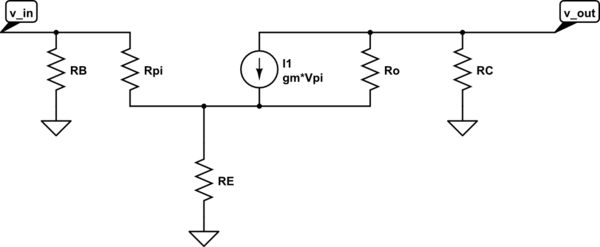There is a problem with the first set of equations that you present: \$ i_E \$ is not equal to \$ \frac{V_{in}}{R_E} \$, and \$ i_E \$ is not equal to \$ i_C \$. For a transistor in forward-active operation, these two statements are not true, either in DC or AC analysis. When you do AC analysis, you can use the hybrid-\$\pi\$ model. The hybrid-\$\pi\$ model turns your BJT into an equivalent network consisting of two resistors and a current source. The characteristic parameters associated with the model are \$ R_{\pi} \$ , \$ R_o \$, and \$ g_m \$, which are small signal impedances and transconductance respectively.
$$
r_{\pi} = \frac{V_T}{I_{BQ}}
$$
$$
g_m = \frac{I_{CQ}}{V_T} = \frac{\beta}{r_{\pi}}
$$
$$
r_o= \frac{V_A}{I_{CQ}}
$$
Where \$ I_{BQ} \$ and \$ I_{CQ} \$ are the DC (quiescent) currents through the amplifier.
Let's work through the analysis of your amplifier.

simulate this circuit – Schematic created using CircuitLab
To simplify the analysis while introducing this model, I'm going to ignore \$ R_o \$ which is allowed because \$ R_o \$ depends on the Early voltage, which is usually pretty large.
Applying a voltage at v_in, get the following expressions:
$$
V_{\pi}\equiv I_Br_{\pi}
$$
$$
I_E = I_B + g_mV_{\pi}
$$
$$
V_{\pi} = V_{in} - I_ER_E = V_{in} - \left(I_B + g_mV_{\pi}\right)R_E
$$
$$
\therefore V_{in} = I_B \left(r_{\pi} + (1 + g_mr_{\pi})R_E\right)
$$
$$
\therefore V_{\pi} = V_{in} \cdot \frac{r_{\pi}}{r_{\pi} + (1 + g_mr_{\pi})R_E}
$$
$$
V_{out} = -R_C\cdot g_mV_{\pi}
$$
With substitution, you can express \$ V_{out} \$ as a function of \$ V_{in} \$ and the characteristic parameters, giving you the voltage gain as
$$
A_v \equiv \frac{V_{out}}{V_{in}} = -\frac{r_{\pi}}{r_{\pi} + (1 + g_mr_{\pi})R_E} \cdot g_mR_C
$$
With some substitution, you can also express the gain of the amplifier in a more compact (and common) form:
$$
A_v = -\frac{r_{\pi}}{r_{\pi} + (1 + \beta)R_E}\cdot g_mR_C
$$



